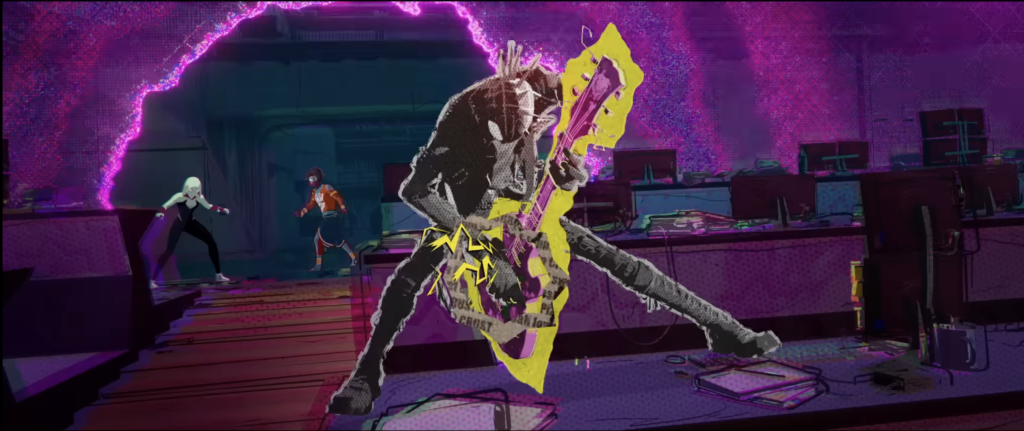Five years after the historic success of Spider-Man: Into the Spider-Verse, viewers were welcomed back to the multiverse of Manhattans where Miles Morales (Shameik Moore), Gwen Stacey (Hailee Steinfeld), and many more “Spider-people” reside.
Into the Spider-Verse took home the Academy Award for Best Animated Feature in 2019 and set a high bar for both the sequel – and any other film tackling the multiverse.
In between 2019 and now, Marvel has given fans no shortage of crossover content.
Spider-Man: No Way Home brought together all three live-action portrayals of Peter Parker, Dr. Strange and the Multiverse of Madness introduced the Illuminati, and Ant-Man and the Wasp: Quantumania’s end credits scene foreshadowed Kang’s domination of the multiverse.
All that being said, Across the Spider-Verse feels completely different from those films thanks to the groundbreaking storytelling and animation that was well worth the five year wait.
The best way to describe watching Across the Spider-Verse is to imagine seeing a comic book come to life in your hands.

Small text boxes written in comic book font appeared when the film changed worlds, and the stunning multi-layered animation gave the characters depth that goes beyond dialogue.
It’s clear that every single frame of the film was carefully curated and purposeful, making the viewer want to rewatch Into the Spider-Verse to catch all the callbacks.
The visuals are obviously the clearest notable feature of Across the Spider-Verse, but the film’s soundtrack is also a major factor in its effectiveness.
Daniel Pemberton’s score for the film makes it a full sensory experience — with electric compositions that perfectly capture every world Miles travels to.
There’s also of course the official soundtrack, produced by rapper Metro Boomin, that includes pieces like “Calling” and “Annihilate” that showcase both the teenager and superhero parts of Miles.
The journey of self-discovery that Miles embarks on in Across the Spider-Verse is a seamless transition for his character.

Everybody knows it’s not easy to be Spider-Man – hiding their identities from their loved ones, saving the city in between studying for the SATs and applying for college, but most of all – feeling alienated from the rest of the world for being different.
This film portrays every aspect of Miles’ struggle with his identity from beginning to end, taking as many twists and turns along the way as one would expect for a Spider-Man story.
When he learns Gwen is a part of a Spider-Society filled with people like them that she never invited him too, of course he feels hurt and betrayed.
But when an unlikely villain appears in the form of The Spot, a lab experiment gone wrong that Miles played a part in creating, he goes against Gwen’s warnings to stay away and embarks on a multiversal journey to try and stop him.
Along the way he meets many members of the society including Spider-Man India (Karan Soni), Spider-Punk (Daniel Kaluuya), and Spider-Man 2099 (Oscar Issac), the leader of the Spider Society.

Spider-Punk was certainly a quick fan-favorite, a punk rock anarchist that uses his guitar as a weapon.
He was animated at a different frame rate than the rest of the characters, a stylistic nod to his nonconformity, and one of the many genius artistic choices made in the film.
Spider-Man 2099 (also known as Miguel O’Harra) is in charge of keeping the multiverse in line and making sure all “canon events” stay on track, but Miles continues to set events off course.
A pivotal moment between Miguel and Miles spirals into the beautifully chaotic final act of the film — including a scene where the entire Spider-Society is sent to chase after Miles.

Viewers see versions of Spider-Man that have never been shown on the big screen before – including the Scarlet Spider, Spider-Cat, and even the Spider-Man popsicle.
Across the Spider-Verse truly takes the multiverse to a whole new level, and it’s incredible to watch this singular scene that took years of work to create and animate.
As Miles tries to get back to his home universe of Earth-1610, an obstacle presents itself that leaves the biggest cliffhanger since half of the Avengers were turned to dust in Avengers: Infinity War.
The ending leaves many questions for Beyond the Spider-Verse to address in 2024, but also a fierce desire for Miles to have peace and happiness in his life for once instead of constant peril.
Since Miles’ life doesn’t follow the typical canon events of the other Spider-People, only time will tell how his story unfolds in the next installment.
Until then, the animation marvel that is Across the Spider-Verse will surely hold over fans of the film series.
Rating: 5/5



